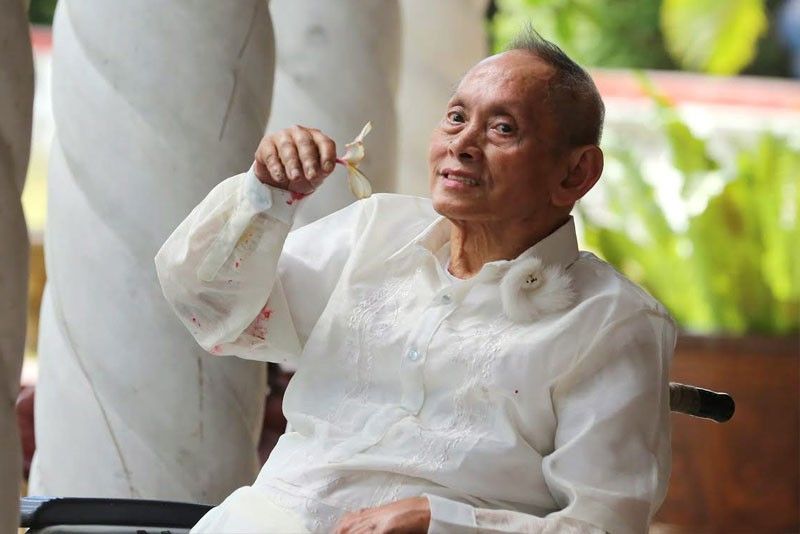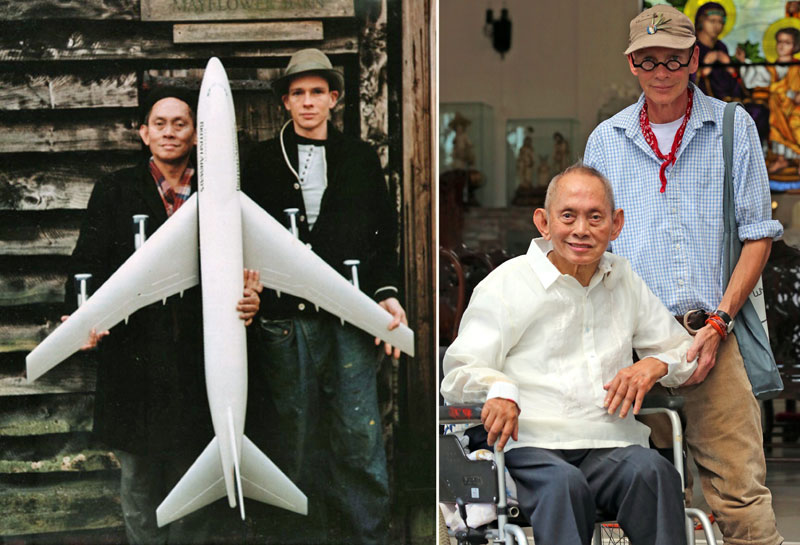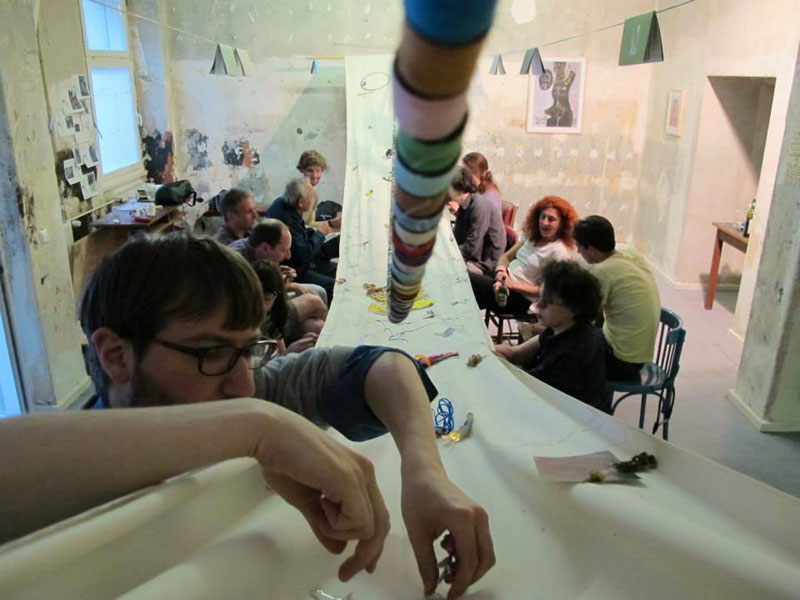David Medalla’s love letter to Transcendence

David Medalla is an artist who did a major rethink about the way art should be defined and presented — as bubbles, as cosmic graffiti, as a fan club to a Dutch artist who painted oracular geometries. Medalla is the original poster or O.P., the thread-starter. For many Filipino art aficionados, he is the G.O.A.T. (Greatest Of All Time), giving “tangible form to invisible forces” since his first shows in the early ’60s in London and Paris. Marcel Duchamp even gave him a medal. Adam Nankervis, David’s partner and longtime collaborator, tied the knot with the artist under a rainbow flag on Valentine’s Day in 2018 in Quezon City. This year, Adam says David will present one of his most iconic pieces at Art Fair Philippines as part of the fair’s special projects.
The “Cloud Canyons” bubble machine (1963) is Medalla’s “Sgt. Pepper’s.” It was one of his first forays into groovy, mind-blowing kinetic art, and was allegedly inspired by several things: David’s mom cooking bubbly guinataan, a brewery in Scotland, a soap factory in Marseilles, the sight of the Grand Canyon, the movement of clouds over Manila Bay, and the sight of a young guerrilla shot down by the garden of the old Medalla house during the Japanese Occupation with “red bubbles foaming from his mouth.”
“A Stitch in Time” (1967) is his “White Album” — eclectic, diverse, varies with each encounter, and participatory. Its origin story involves the closing of old textile mills in Manchester. It started out as David’s homage to the disenfranchised workers, but over time it has acquired deeper, wider resonances.
For this particular installation, a long piece of cloth is hung along with needles and motley-colored threads while visitors are encouraged to sew their names, messages, coins, candy wrappers, photos, cigarette butts, poems, bus/train tickets, anything that represents personal memories or simply random, seemingly impulsive stuff. Various incarnations have been spotted in shows in London, Utrecht, Kassel (for Documenta 5 curated by Harald Szeemann), Edinburgh, Texas, New York, LA, Berlin, Paris, Lisbon, Tokyo, Singapore, Barcelona, Johannesburg, Kiev, Sao Paolo, Rome and Venice (for the 2017 Biennale, which spanned 13 meters length). This will be the first time “A Stitch in Time” will be — as Adam puts it — “activated” in the Philippines, and Medalla will accordingly make use of jusi, piña, local twine and a “bahaghari of colors.”

A 25-year challenge: David Medalla and Adam Nankervis in front of the Mayflower Barn, 1994; the two in front of the chapel at MiraNila Heritage House and Library in QC, 2019.
Nankervis explains, “By adding to the piece, it becomes something communal and accumulative, an amazing tapestry of time and space.” David, Adam and I are sitting by the chapel of MiraNila Heritage House and Library in QC. Slated for today is a Thanksgiving Mass. Petty Benitez-Johannot is facilitating the activities of the day, which includes “The Archive Project in Berlin” talk by Daniel Kupferberg. Medalla is resplendent in a barong, while Adam walks around in a traditional Lederhosen. The artist has been suffering from health issues for the past year, although Adam says David is “recovering wondrously, drawing and creating art every day.”
Nankervis says the idea for “A Stitch in Time” was to find a place of your own in the larger context of the macrocosm. It is a very liberating work to partake in — so, these woven pieces are beautiful existential capsules. “But in recent years, the dialogue has become more global. It is David’s wish to create a ‘Stitch in Time’ piece that will start in one location and embark upon a journey around the world.” With the citizens of the world sewing a little bit of themselves into the fabric. A patchwork of souls. A more inclusive, non-bordering flag.
And there are a million anecdotes that follow “A Stitch in Time.”
In Venice, someone had brutishly extinguished a cigarette over the piece. Medalla took one look at it and said, “All right, fair enough.” But two days later, he discovered that somebody had delicately fixed the “wounds” so to speak, sewing patterns around the cigarette burns to beautify them. “People will respond differently, that’s the majesty of it.”
Medalla recalls the time a person came in wearing torn jeans, and he offered to sew them. That incident made Adam laugh. “David has been known for mending clothes. I’ve seen it.”
The artist shares how one guy came in with a pair of scissors. “He cut a piece of ‘A Stitch in Time’ and tried selling it.”
“Really?!!!” asks Adam. “Was he successful?”
“Yes,” intones David. “It was sold to an American collector.”
Adam is amused. “We should start flogging it like the Holy Grail (laughs). No, seriously. We don’t encourage that.”

Visitors participating in the creation of Medalla’s “A Stitch in Time.” Photo from www.anothervacantspace.com
Medalla explains how another incident (aside from the textile factory shutdown) inspired him to come up with the piece. Two of his lovers came to London in ’66 or ’67. He gave each of them a handkerchief (one black, one white) with some needles and spools of cotton thread. He also told them they could stitch anything they like on the hankies (on which the artist had already stitched his name and a brief message of love). Many years later, while waiting for his flight back to England at Schiphol Airport in Amsterdam, he noticed a young man with backpack. Attached to the backpack with safety pins was one of the handkerchiefs which was now festooned with “old Chinese coins, fragments of broken bamboo whistles, dried leaves, torn cigarette packets and all kinds of embroidered messages.” It had become a beautiful assemblage of trinkets. And it had traveled around the world, gathering memories and mementos along the way, transcending its original raison d’être.
This incident still resonates with David to this very day. And he is continually surprised at how people have responded to this piece that pays tribute to British textile workers, and was inspired by two lovers in London in the Swinging Sixties with its imagined tangle of tangerine trees and marmalade skies.
Adam says, “At the Biennale, a guy sewed a letter onto the fabric. The letter was meant to be sent by post to his brother, but the guy found out upon arriving in Venice that his brother got killed. He held on to that letter. When he saw ‘A Stitch in Time,’ he decided it was the best place for that letter to be.”
You can consider David Medalla’s “A Stitch in Time” as a sort of human beings’ letter to the rest of humanity. Profundities abound, a moving pageant of memory and forgetting — one man’s letter to his dead brother, a baby birth bracelet, testaments of unrequited love.
Oddities abound as well.
Aside from cigarette butts and toiletries, you can also find — according to Medalla and Nankervis — “people’s naked Polaroids of themselves.”
Adam recalls all this with a chuckle. Meanwhile, David grabs a flower that had fallen to the ground and gestures upwardly. “This should go to the altar,” mumbles the artist, probably imagining an installation for the heavens. This man has built a career out of taking everyday objects, putting them together, and making them transcendent. The chapel’s stained glass fills everything with color.



















